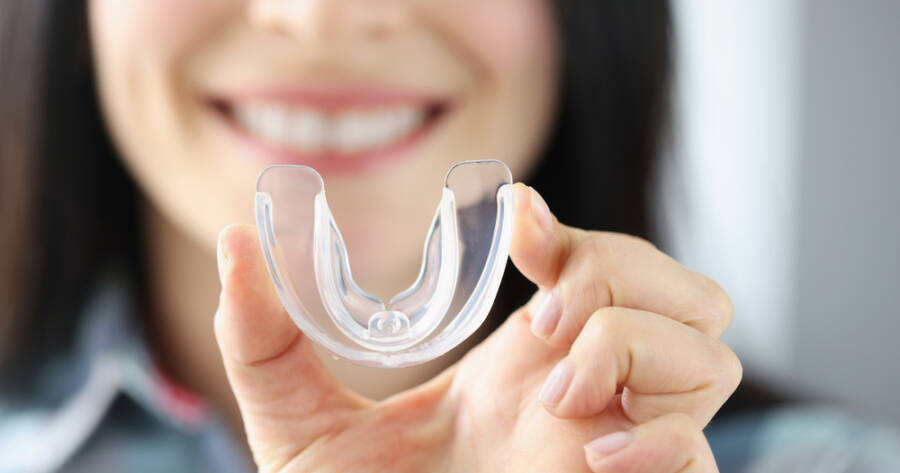TMJ (temporomandibular joint disorders) is a condition that commonly impacts the jaw joints. It can lead to discomfort and pain in the muscles around the face. Fortunately, you can learn everything you need to know about TMJ with a search online.
There are methods to alleviate the discomfort without having to rely on surgery or strong medications. These include easy and affordable lifestyle modifications. Let’s explore some of the solutions that may work for you.
1. Use a Night/Bite Guard
Many people unknowingly grind or clench their teeth while sleeping, exerting pressure on the jaw’s bones and muscles. This can also occur during the day due to stress or fatigue, often without conscious awareness, exacerbating the issue.
The Mayo Clinic recommends a bite guard as an effective way to manage TMJ. These guards are affordable oral devices that fit snugly over your teeth. Although their exact mechanism in treating TMJ is not completely understood, as per The Dental Lab, bite guards have been used since the 1930s to prevent teeth grinding and clenching.
2. Try Acupuncture
Acupuncture involves inserting fine needles at strategic points to stimulate muscles and alleviate pain. Johns Hopkins Medicine advocates for its use in treating TMJ symptoms. There is robust evidence of acupuncture’s effectiveness in reducing jaw pain and notes that it can be used alongside other methods for enhanced results.
Acupuncture can provide long-term relief from TMJ discomfort, though the required number of sessions may vary based on the severity of the condition. A Swedish study conducted in 2008 revealed that patients who underwent acupuncture treatments up to 20 years ago still experienced reduced TMJ symptoms.
3. Employ Biofeedback and Meditation
Biofeedback is a technique that helps reduce jaw tension naturally through sensor-assisted training, as explained by Kaiser Permanente. This method includes visualization exercises to relax facial muscles, with sensors monitoring the effectiveness.
Pro Teeth Guard suggests that meditation can be equally beneficial without needing equipment. Mindfulness meditation is a skill that improves with practice. Studies have shown its superiority in pain relief compared to placebo treatments.
4. Implement Jaw-Strengthening Stretches
According to the Mayo Clinic, simple stretching exercises can strengthen jaw muscles and enhance mobility. These stretches, best taught by a doctor, dentist, or physical therapist, can optimize results.
Physical therapists might also introduce methods like applying cold/heat packs to the face. They may use additional pain relief techniques such as ultrasound in their clinics, but the most effective remedies are simple, home-based practices without the need for complex equipment or training.
5. Pay Attention to Your Posture
Often, pain in one body part is linked to strain or weakness in another, and this holds true for TMJ. Ergonomics, particularly posture, plays a significant role in the functioning of joints and muscles. Prolonged slouching, especially in an office setting, can exacerbate the problem.
Hours of poor posture increase the strain on muscles, which then try to compensate for the imbalance, leading to facial and neck pain and fatigue. Regularly changing positions and ensuring that arms are resting comfortably are ways to reduce strain. If these adjustments don’t help, consider investing in an ergonomic chair.
6. Understanding the Impact of Diet and Nutrition
Diet and nutrition also play a crucial role in managing TMJ symptoms. Certain foods can exacerbate jaw pain and discomfort. For example, hard or chewy foods can put additional strain on the jaw muscles and joints, potentially worsening TMJ symptoms. On the other hand, a diet rich in anti-inflammatory foods may help reduce inflammation and pain associated with TMJ.
It’s advisable to consult with a nutritionist or a healthcare professional to understand which foods might trigger TMJ symptoms and which could potentially aid in alleviating discomfort. Making informed dietary choices can be an integral part of a comprehensive approach to managing TMJ.
Final Thoughts
From using night guards to prevent teeth grinding to exploring acupuncture for pain relief, employing biofeedback and meditation techniques, practicing jaw-strengthening exercises, and being mindful of posture, there are numerous ways to manage and alleviate the symptoms of TMJ. Additionally, understanding the impact of diet and nutrition on TMJ symptoms can further aid in creating a holistic management plan.
With the right combination of treatments and lifestyle adjustments, it is possible to significantly reduce discomfort and improve quality of life. It’s important to remember that what works for one person may not work for another, so it’s crucial to consult with healthcare professionals to tailor a treatment plan that meets individual needs and circumstances. With patience and persistence, those suffering from TMJ can find effective ways to manage their condition.
